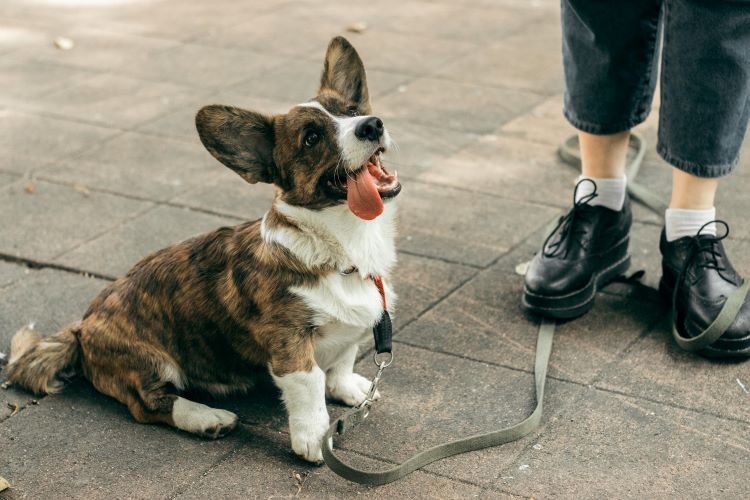Ready to help treat your pet to a healthy life?
How Often Do Dogs Need Bathroom Breaks?
By : Kathleen Crampton | Published Jul 22, 2025

Whether you're new to having a pup or just curious about how things work, you've probably wondered how often dogs need to go to the bathroom. Is there a best time of day? Does it change depending on their age?
Nobody wants to deal with accidents indoors, and you also don’t want your dog risking health issues because they aren’t getting out enough. Experienced pet owners tend to get a feel for these things of course, but it’s always a good idea to learn what’s actually normal and healthy for dogs. From how often dogs should be taken out to why a regular bathroom routine matters, here’s what you need to know to keep your pup comfortable and happy — and avoid accidents.
The importance of routine for your dog
Routines are important for all dogs. While their days can of course have varied activities, following general patterns for eating, resting, exercise, and yes, going to the bathroom, helps our canine friends develop and maintain a sense of safety and security. But don’t overlook your dog’s most basic of needs. In addition to consistent mealtimes and daily walks with your dog, a bathroom routine is crucial.
Of course, it’s also about health. Taking your dog out to relieve themselves at routine intervals helps your pup avoid developing a myriad of problems, like urinary tract infections (UTIs), bladder infections, or bladder stones, all of which can be caused by waiting too long for a dog potty break. It’s also worth noting that getting familiar with your dog’s routine will help you be able to spot problems, as some conditions (like kidney disease, UTIs, and diabetes mellitus) can cause increased urination or other disruptions to your dog’s need to go.
Establishing a routine for bringing your dog outside should start the same day you bring them home, whether they’re a puppy or an adult dog. This will help them get acquainted with their new home and lifestyle and start developing a bond with you as their pet parent. For puppies especially, potty training is the ticket to lifelong success in not just the bathroom department, but other areas of essential dog training.
Dog potty needs by age
While circumstances like health conditions, medications, breed type, and size can certainly affect how often your dog has to go to the bathroom, the average number of dog potty breaks per day is typically determined by age.
Puppies (up to 18 months old)
Puppies’ small bodies mean that they have smaller bladders than adult dogs. Plus, as younglings, they’re learning how to control their bathroom urges. This is why puppy potty training is crucial — so that pet parents give their little pal the ability to relieve themselves at regular intervals and teach them bladder control.
While your dog’s exact needs will vary, puppies should generally be let out to pee every 45 minutes or so. Yes, that sounds like a lot, but remember that this is just a phase, and you’re setting them up for long-term success! Develop a bathroom routine where your puppy can relieve themselves first thing in the morning, after mealtimes and play sessions, right before bed, before leaving the house, and upon returning home.
As they get older, you can begin increasing the amount of time between bathroom breaks according to their age. So, a four-month-old puppy should be able to hold their pee for three to four hours while a five-month-old should be able to hold it for four to five hours. By the time your pup is around 6 months old, they should have the ability to wait about six hours, which indicates full bladder control. Of course, these time frames may vary by pup, breed, and your vet’s recommendations.
Adult dogs (18 months to 10 years old)
Adult dogs should be let out to do their business approximately three to five times per day and should not wait more than six to eight hours between breaks.
Adult dogs poop once or twice a day, on average, and usually soon after meals. They’ll need to pee more often. So, at a minimum, aim to let your dog outside first thing in the morning, after mealtimes, and before bed.
Senior dogs (10 years and up)
Older dogs often need to go to the bathroom more frequently than their younger counterparts, as they might lose some bladder control and could suffer from medical conditions that require them to urinate or poop more often. Take care of your favorite senior canine by giving them a potty break every four to six hours.
For elderly dogs, be sure to consult a veterinarian to ensure that their bathroom routine aligns with their specific needs.

Signs your dog needs to go out
Even with a consistent dog bathroom schedule, your pup may need to relieve themselves outside of the usual times. There are many non-concerning reasons that could lead to a change in their typical routine — maybe they drank more water today or are on a new diet. Dogs on certain medications, notably steroids, may also be thirstier and need to urinate more often. In these cases, they’ll likely show signs of needing to go outside:
- Intensely sniffing the floor, a rug, or furniture
- Pacing or standing near the door
- Whining, whimpering, or barking
Pet parents get to know their dog’s unique body language over time, but these are some common signs that they’re in discomfort and need to go potty. Just remember to practice good dog owner etiquette and bring their leash if you’re headed to a public space!
Now, if there is a sudden change in your dog’s frequency of bathroom breaks, it’s best to contact your vet for guidance. As noted earlier, urinating too frequently could be a sign of a urinary tract infection or other health issues, while going too long without pooping could indicate constipation. Your vet can help you understand if your dog’s behavior is cause for concern and provide their professional medical recommendations.
Protect your dog’s health indoors and out
Taking care of your pup means prioritizing their health and well-being, from maintaining their daily dog bathroom schedule to feeding them a nutritious diet. Going beyond the day-to-day, it also means bringing your pet in for routine veterinary visits and budgeting for medical care they may need. Since, unlike your dog’s bathroom schedule, you can’t predict surprise illnesses or accidents, dog insurance is a good idea for protecting your pet against the unexpected.
